A discovery phase in software development is more important than you may think. This is the time when you get to establish a clear project scope, create estimates, and identify and plan how to mitigate potential risks without extra expenses.
When executed properly, the discovery phase creates a solid foundation for the whole software development process. Skipping this phase may lead to developing a product that users don’t want and competitors aren’t scared of.
In this article, we analyze the essentials of a discovery phase and discuss why you should never skip it in your projects.
This article will be helpful for product leaders who want to mitigate risks and optimize outcomes when launching a new software development project.
Contents:
What is a discovery phase in software development?
The project discovery phase is the first phase of the software development lifecycle (SDLC). It mainly consists of research activities aimed at collecting all necessary information regarding the future product, market, competitors, user expectations, and business value. The main goal of the project discovery phase is to lay the foundation for the development process.
As a result of this phase, you will receive a detailed scope of work along with accurate estimates of resources needed for your software development project and a potential risk assessment.
Sometimes, the results of the discovery phase may show that it’s better not to work on the project at all. For example, research might show potential risks that are hard to avoid and which can lead to unreasonable expenses, or that the market is deluged with competitors who are too strong to beat. In this case, conducting a discovery phase can save you from big losses in the future.
Depending on your project’s complexity and your chosen methodology, the discovery phase can last from a couple of days to a couple of weeks or even months. However, the time and resources spent are worth the benefits to your business. Let’s take a closer look at what you can expect.
Looking for project research & discovery experts?
Get a detailed analysis and a solid project development plan with clear estimates! Apriorit’s professional business analysts are ready to help you with project research.
5 benefits of a discovery phase
Before starting your project with a discovery phase, it’s important to know what outcomes you can expect as the result. Most commonly, businesses count on the following five benefits:
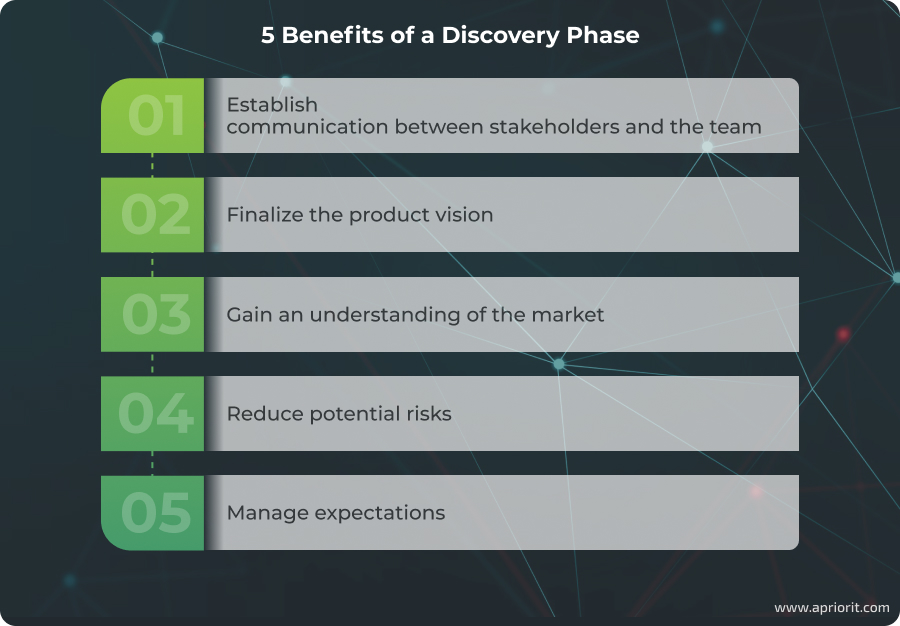
- Establish communication between stakeholders and the team. Regular communication during the project discovery phase allows you to evaluate how the development team works, their expertise, and their approach to the project. In turn, in-depth discussions help the development team better understand your business needs along with technical requirements and choose the most relevant technological solutions.
- Finalize the product vision. In-depth discussions about the main objectives and project goals are essential to finalize the project vision. They help your team define the required functionality, find flaws in the current product concept, and come up with fresh and relevant ideas.
- Gain an understanding of the market. Assessing a market and analyzing competitors allows you to identify user needs before starting product development. Thus, you can eliminate the risk of developing unnecessary features at early stages and plan for functionality that your target audience actually wants. At Apriorit, business analysts (BAs) conduct all required research, so our clients only need to provide existing project information.
- Reduce potential risks. Knowing risks to expect helps you avoid violating release deadlines and going over budget. A thoroughly conducted project discovery phase allows you to deliver a product that meets user needs. It also helps you choose the most relevant technologies for software development so that your team doesn’t face costly fixes at later development stages.
- Manage expectations. The results of the discovery phase provide you with a comprehensive view of the project: a defined feature set, realistic deadlines, estimated costs, and more. This knowledge can help you eliminate surprises and align your business strategy with software development progress. However, this doesn’t mean you can’t change anything. Every business changes, as does the market situation, so your team should always be ready to make changes to the plan upon your request.
A successful discovery phase of a software development project is a result of your mutual work with the development team. Let’s explore who participates in this phase and how to ensure a positive outcome.
Who participates in the project discovery phase?
The discovery phase for software development is handled mainly by business analysts. However, you should consider engaging other project team members who can contribute their experience and knowledge.
Roles you may need to engage in your project’s discovery phase include:
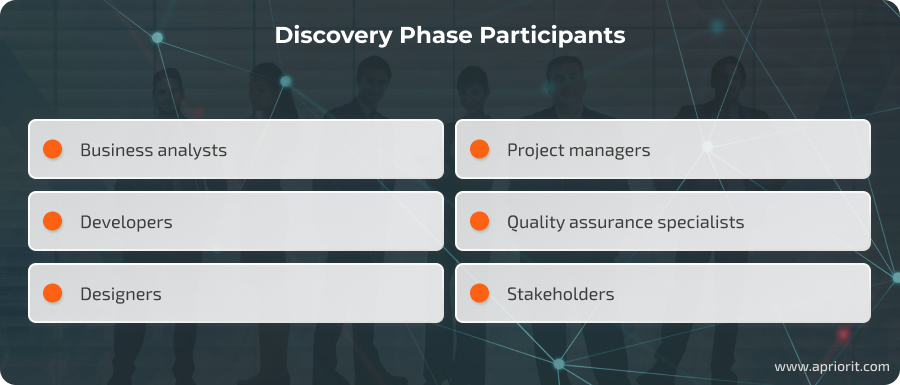
- Business analysts are responsible for analyzing business needs, stakeholders, and competitors. BAs also analyze a project’s current state, define its desired state, determine the target audience, and prepare project documentation.
- Project managers organize the development team’s work, create a project plan and statement of work, prepare time and cost estimates, inform stakeholders on the project status, and assess risks.
- Developers research options for the project’s architecture, create an architecture design, and prepare a solution architecture document.
- Quality assurance specialists work on test strategy and early test design.
- Designers prepare mockups or prototypes and make sure they match the elicited requirements.
- Stakeholders may also be considered participants, as they provide essential details about the project, participate in interviews and requirements elicitation, and review and confirm the final documentation.
Pro tip: BAs and developers often work simultaneously to save time. On one of Apriorit’s projects, we needed to build an IVR system and new APIs for an existing solution. To speed up the process, while our BA was working on the flow of interactive voice recognition functionalities, our software architect researched possible technical solutions. Then, they prepared a technical prototype to share with stakeholders and make sure the team was moving in the right direction.
Now, let’s look at the main stages of the discovery phase of a software project and discuss why they’re important.
Read also
Effective Software Requirement Specifications (SRS): Apriorit’s Approach
Explore criteria for evaluating SRS quality, challenges of SRS development, and Apriorit experts’ approach to creating effective SRSs.

Main stages of a project discovery phase
The processes and stages of a discovery phase may vary depending on what product your team is working on. However, we can outline key stages for the majority of projects.
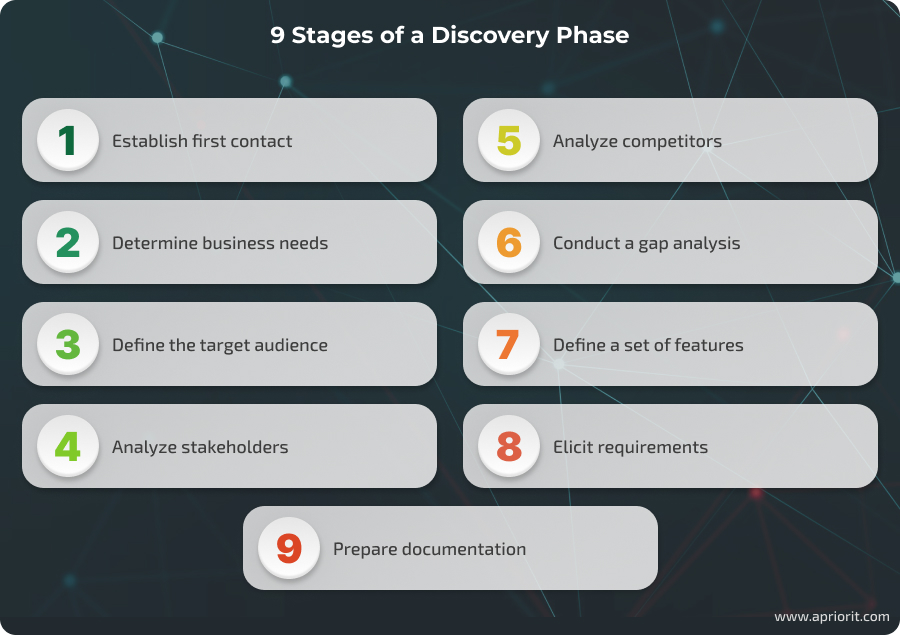
1. Establish first contact
The discovery phase process usually starts before you even sign a contract with your outsourcing partner.
For example, when a potential client approaches Apriorit with a project idea, we give them a rough estimate for it almost immediately. If the client preliminary approves this estimate, our BAs contact them to create more detailed estimates. Once an agreement is reached, we sign a discovery phase contract.
2. Determine business needs
At this stage, BAs help you accurately define the business need behind the solution. They dig into your change request and thoroughly prepare for interviews to find out the purpose of each requirement. Thus, BAs ensure the project is realistic, practical, and meets your needs.
Identifying business needs is essential for further product development because it:
- Gives the entire development team a full understanding of the desired solution
- Helps connect your vision of the product with relevant technical solutions
- Aids developers in creating software according to your expectations
Pro tip: Always make sure that features actually bring benefits. Having vast experience in analyzing software environments, Apriorit’s BAs thoroughly check which features will contribute to the client’s business needs and which may harm them or be useless.
For example, one of our clients wanted to create sensors and software to monitor vacant places in a workhub to properly direct internet traffic. However, business analysis showed that the solution would be so expensive and complicated that it wouldn’t meet all the requirements of hub owners.
3. Define the target audience
Without a deep understanding of your target audience and what tasks they will complete with the product, it’s impossible to know which functionality will make your solution valuable. To define your target audience, you can use demo products, focus groups, surveys, and A/B testing. At the initial phase of a project, BAs often create user personas, which describe prototypical members of the target audience who have particular issues and ways they currently solve them.
Defining the target audience will help you not only with designing the user journey and user experience but also with marketing your product.
Pro tip: If your employees are also users of your solution, ask BAs to create a job description document that defines the jobs that exist in the company and their responsibilities. On the one hand, this helps BAs identify user roles and what level of permissions they should have in the system. On the other hand, this document can help you detect and prevent security risks.
For example, when working on a web service for property management, our BA noticed there were a lot of people within an organization who could access that service. After preparing a job description document, we were able to clearly separate access rights for specific roles. For instance, a supervisor was able to delete property profiles from the system, while a manager could only view the profiles of a certain group of properties.
Read also
Business Analyst Roles & Responsibilities in Software Development
Gain insights into the critical role of a business analyst in software development and how BAs bridge the gap between stakeholders and development teams.
4. Analyze stakeholders
Conducting stakeholder analysis allows you to define stakeholders’ roles in the project. The major benefit of stakeholder analysis is that it simplifies and accelerates communication between the development team and project stakeholders. Stakeholder analysis also helps the development team promptly react to changes in requirements on account of regulatory compliance.
Your team can use various methods to conduct stakeholder analysis. At Apriorit, we usually use the stakeholder onion diagram and the Responsible, Accountable, Consult, Inform (RACI) technique.
The stakeholder onion diagram clearly shows the level of each stakeholder’s engagement and how close stakeholders are to the solution. This diagram looks similar to a cut onion, with the solution placed in the center.
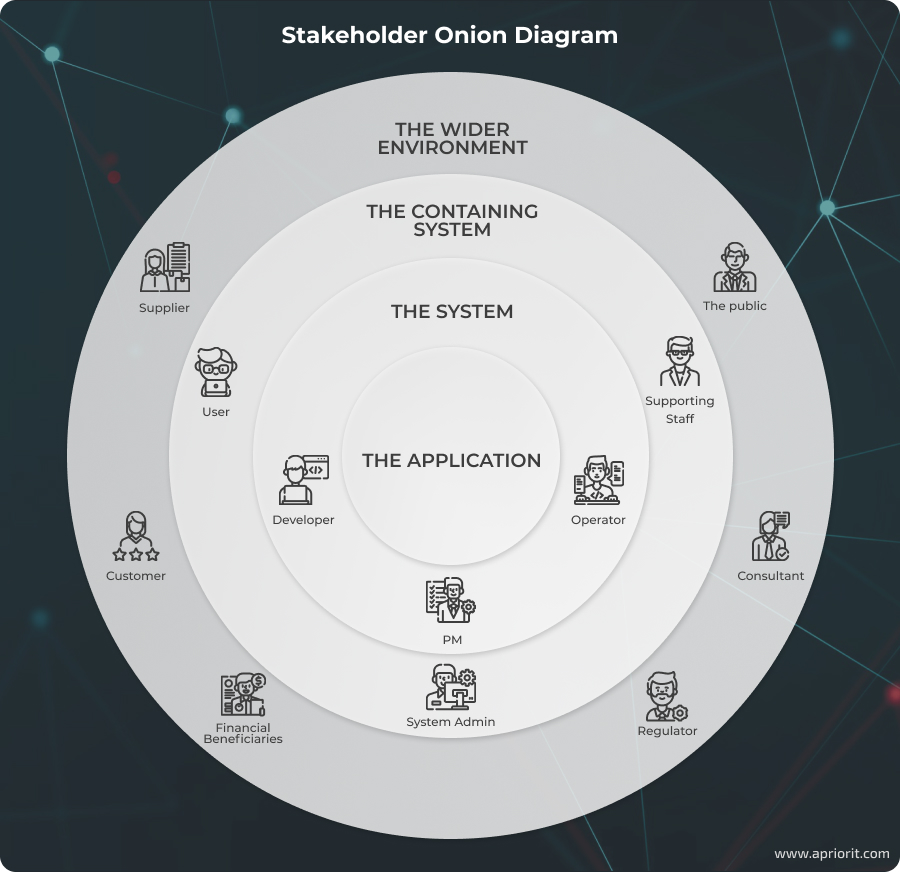
You can always revise the results of stakeholder analysis if new stakeholders join your project or existing stakeholders change their vision.
Pro tip: Stakeholders are not always people and can be represented in the form of policies, regulations, laws, standards, rules, and systems. For example, when our BAs worked on MDM system implementation for a healthcare-related project, they treated HIPAA as a stakeholder because this act had a big impact on the solution and its design.
5. Analyze competitors
Studying competitors allows your team to examine solutions and features that are already on the market.
Competitor analysis usually has three levels:
- Level 1. BAs analyze the most common solutions and their features in the domain. This gives them an understanding of what to expect on the market and helps them find out which tools end users consider the most valuable.
- Level 2. BAs compare existing systems and highlight features that are worth your attention.
- Level 3. BAs evaluate the size of competitors, the frequency of releases, and their share in the market. This usually requires access to paid reports and tight collaboration between you and the BA.
Leveraging AI-powered tools like Coefficient or AnswerRocket for processing and analyzing large quantities of competitors’ data can help save your business analysts’ time and result in a more detailed and comprehensive competitor analysis.
6. Conduct a gap analysis
A gap analysis is an investigation of the difference between where your project is now and where you want it to be. It consists of three key steps:
- Gathering data on the current and desired project states
- Comparing these states and identifying gaps between the current state and the desired state
- Defining areas for improvement
Once the analysis is ready, its results are gathered in a summary table that describes the current challenge, its root cause, and steps to address it (e.g., adding new functionality, conducting training, or creating new reports).
Here’s a simple example of a gap analysis for a healthcare company:
| Current state: | Employees need to manually open patients’ profiles in the system and download PDF files attached to them one by one. |
| Desired state: | Employees can download files in bulk. |
| Root cause (the gap): | A manual process limits overall efficiency. |
| Steps to fix: | Automate the process of downloading files. |
By applying the gap analysis technique, you will gain a clear vision for your project’s development and will be able to thoroughly plan your team’s work.
Read also
Requirements Elicitation: Reasons, Stages, Techniques, and Challenges
Learn the benefits and challenges of requirements elicitation, its main stages, and the techniques we most frequently use at Apriorit to elicit requirements efficiently.

7. Define a set of features
After figuring out the project’s goals, target audience, and current market situation, the development team defines a set of product features. Three main factors that influence the feature set are:
- The product’s goal and all steps of the user journey that lead to its fulfillment
- Industry standards
- The project budget
To find out what functionality is essential for your target audience, BAs can help you define the basic set of features for building a minimum viable product (MVP). After releasing an MVP and getting the target audience’s feedback, you and the team can make changes to the feature scope and enhance the user experience.
8. Elicit requirements
At this stage, the project is starting to take shape. BAs are working on a specification document that defines all of the product’s technical, functional, and usability requirements.
To elicit project requirements, BAs often work with a technical architect who picks a technology stack to ensure that the product is maintainable and scalable.
During this stage, you and your technical specialists can also determine the technical risks that may influence the project’s scope and delivery time.
9. Prepare documentation
Finally, the development team prepares detailed and clear project documentation that represents the discovery phase deliverables and allows you to proceed to the next phases of the SDLC.
Thoughtfully prepared documentation will help you and your development team to:
- Validate all essential project details
- Work out the final requirements
- Achieve a mutual agreement on the project specifics
- Make sure everyone is on the same page
The scope of documents may vary depending on the project’s type, size, and industry.
The above steps help the development team fully grasp the project’s business needs and enable them to accurately plan their work and introduce a solution that meets all your expectations.
Project discovery phase deliverables
As a result of the discovery phase, you will get a clear and thorough understanding of the project, from business goals and design to features and technologies. Below, we list common categories of deliverables that you can receive at the end of a project discovery phase.
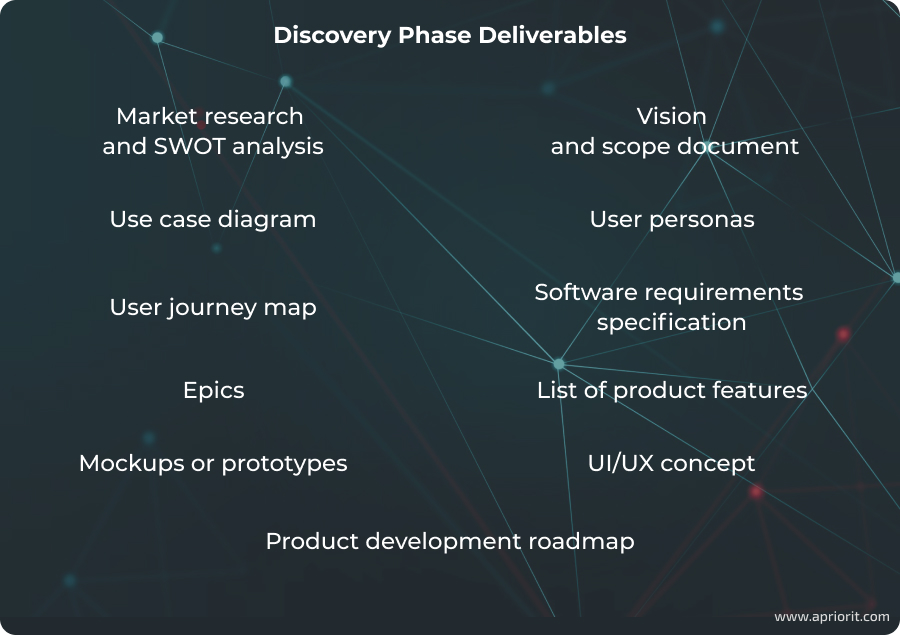
Market research and SWOT analysis describe the current state of the market, the competitor landscape, and the business’s strong and weak points. You can use this information to get the upper hand vis-à-vis the competition.
A vision and scope document defines your vision, the goal of the project, and the steps necessary to reach that vision. Apart from basic details like the project’s name, overview, and users, this document also contains:
- Business requirements: objectives, success metrics, vision statement, risks, assumptions, and dependencies
- Scope and limitations: main product features, the scope of initial and subsequent releases, limitations, and exclusions
- Business context: stakeholder profiles, project priorities, and deployment considerations
A use case diagram represents relationships between users and the system. It also helps you to define the project’s scope. For example, if a user is a medical transportation provider working in a CRM system, they may participate in the following use cases:
- See a list of rides
- Accept rides
- Decline rides
- Build routes online
A user persona is a portrait of a typical user who interacts with the system. User personas help your development team better understand the needs of actual end users and focus on features that are truly wanted and needed. User personas may contain various details like age, family status, location, occupation and main responsibilities, background, and character traits.
A user journey map describes the steps end users take in the system, obstacles they face, and their feelings about the solution. A user journey map usually includes user steps, actions, touchpoints, pain points, and the developer’s solution to mitigate those pain points.
A software requirements specification (SRS) contains the project requirements that BAs elicit from stakeholders. Business analysts usually start working on the SRS during the discovery phase and add new information as they communicate with stakeholders and developers.
Epics represent the entire functionality or a big part of it, including user stories.
A list of product features contains minimal detail and will be discussed and augmented later.
Mockups or prototypes depict the proposed solution complementing the SRS.
A UI/UX concept shows the business logic and overall feel of the project. It demonstrates how to achieve the project’s goals during interactions with a user. The UX discovery process is tightly connected to user personas and project goals.
A product development roadmap is a detailed delivery plan that ensures the product’s delivery within budget and according to the schedule.
Since this phase involves multiple and complex activities, it’s not always enough to engage in-house capabilities only. In this case, outsourcing the project discovery phase to a team of professionals like Apriorit can significantly facilitate the discovery process.
Read also
How to Share IT Compliance Responsibilities at Different SDLC Stages
Find out how to share compliance responsibilities with an outsourcing team at every stage of the SDLC to deliver a secure and compliant product.

How can Apriorit help you with a project discovery phase?
With extensive industry and technology expertise — and adhering to the key principles of the secure software development lifecycle — Apriorit specialists will help you smoothly complete all stages of the discovery phase.
Our specialists will help you assess possible security risks and analyze relevant regulations to account for them in your software requirements.
A team of Apriorit professionals will help you:
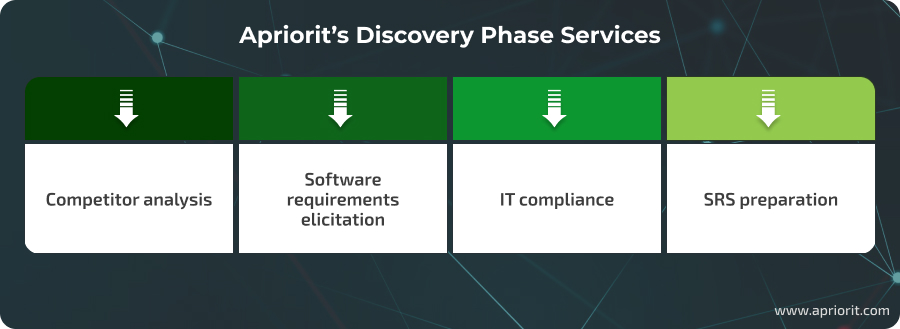
- Conduct competitor analysis to define a competitive scope of features to be implemented.
- Elicit software requirements to make them clear and complete.
- Establish IT compliance to ensure that your product meets all relevant requirements.
- Prepare an SRS to describe the product to be developed, including functional and non-functional requirements.
As a result of the discovery phase conducted by Apriorit, you will get:
- A structured plan of work for developing or improving your solution
- Accurate time estimates and deadlines
- An estimate of the total project cost
- Project scope with a technical specification
- A mockup or prototype of the requested solution
If you are satisfied with the results of the discovery phase, our dedicated team can move on to building the final product.
Conclusion
As a starting point in the SDLC, the discovery phase directly influences all other phases. It lays a solid base for your future project: estimates for the required time and budget, definition of the product’s purpose, and predictions for associated risks. All this helps your team detect possible challenges and address them before development even starts.
At Apriorit, we know exactly why it’s crucial to conduct discovery phase activities to create a top-notch solution. Our business analysts will assist in reaching a common project vision within the whole team, defining what resources you need, detecting possible pitfalls, and finding ways to overcome them.
Need a reliable team to drive your project forward?
Employ Apriorit’s dedicated teams to enrich your project with top-tier software development expertise at all stages of the SDLC.


